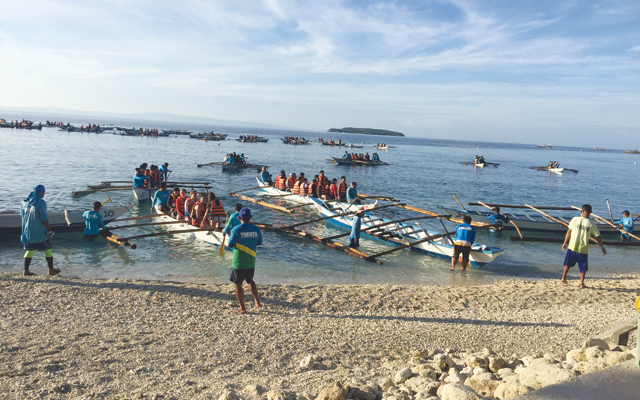Rosa Ocampo takes a closer look at the fishy whale shark practice in Oslob, and is adamant that something has to be done about the ecological imabalance

Whale shark watching in Oslob, Cebu is disturbing, the exploitation of these gentle giants abhorrent. But that’s getting ahead of how this profitable attraction, and all its flagrant violations of ethical, responsible and sustainable tourism, remains untouchable.
In August, a visiting American friend and I drove two hours from Cebu City to Oslob to see whale sharks, locally known as butandings. The daily watch and interaction begins at 06.00 in the morning, ending before noon. When we reached the centre at 06.30, it was noisy and teeming with local and foreign tourists. I counted more than 30 boats already in the waters.
There is a short orientation for tourists, only in English. How would non-English speakers cope? Held every 10 to 15 minutes, there are at least 50 tourists per orientation. The lady doing this has memorised her spiel, including the do’s and don’t’s like no touching of the butandings and no use of sunblock lotion. Questions are not encouraged and there’s no video support.
It seems easy to break the rules. For instance, have they bothered to check how many applied sunblock lotion that day? What did they do to penalise the violators?
For a 30-minute thrill, foreign tourists pay US$21 to snorkel while locals pay US$11 to snorkel and US$6 to watch the butandings from the boat.
It’s a lot of money for the 200 or so fishermen. I was told that they earn up to US$530 a month, a tidy sum in that part of the country compared to what they would have earned from fishing – which they have stopped altogether.
I stayed on the boat while my friend opted to snorkel. The boats are about 15 meters away from the shore, and the water is about 4.5m deep. Since a butanding can be about 4.5m in width, it cannot be in a comfortable horizontal position in that water level. The boatman told me they also have to make the butanding “stand” so tourists can see it.
The feeder on the boat has krill that stunk and attracted flies. This is the controversial daily feeding that’s been going on for years. Whale sharks equate the boat and people with food so they come unafraid.
As such, many tourists also choose come here because of guaranteed sighting unlike in Donsol, Sorsogon which has strict rules protecting these butandings.
The boatman said that each butanding needs 30kg of krill daily and there can be four to five in a day. There isn’t enough krill in Oslob so they buy from Dumaguete, Negros Oriental and freeze them.
I know from a previous whale shark experience in Donsol that butandings feed on plankton. These migratory creatures head to Donsol when plankton is in season then go elsewhere during off season. In contrast, butandings overstay in Oslob due to the daily feeding. I wondered whether krill was nutritious enough. Plus, how does the daily feeding affect the marine eco-system in Oslob, and the life and habits of these gentle giants?
My friend declared that snorkelling with butandings was the best highlight of her Cebu trip. But this was followed by a long discussion. For how long can the fishermen use poverty as an excuse to exploit the whale sharks?
My friend said the fishermen need to be informed and educated, and there are other ways of making this a better tourist attraction without harming the whale sharks.
For example, there’s no coffee shop nor restaurant nearby. It would be a good idea to open a restaurant, and perhaps a B&B. They can also improve the layout by moving the carpark from the beach front, add a souvenir shop, and offer a tour package that includes the nearby sandbar, hot springs, and waterfalls.
Upsetting as it is that these fishermen are exploiting the whale sharks, to me the bigger questions are what are the Department of Tourism, travel trade associations, local government doing to and start protecting the whale sharks, while educating these fishermen. Do they even care at all?





















These Are Tourist Whale Sharks!
Various whaleshark come and go here, Oslob has become an attraction for them. The whaleshark you will meet are tourists like yourselves. Come and meet them! What’s happening is documented and widely dispersed through various media. It is actually changing the world in a way. Because of the interest and compassion of the original men fishing this has become a sensation worldwide, other fisherman in other oceans take note. It is widely hoped that this stunning example of good will towards these creatures will be a beacon to others across the globe and the hunt for them lessened. Perhaps others will turn their fishing vessels into sightseeing crafts, this is an inspiration!
So long as they remain free to come and go unharmed they will choose if they want to meet the people, there is more krill in the ocean after all elsewhere. It is more than the krill that they linger for. Perhaps they are feeling the same thing watching the humans as the humans are feeling watching them. It may be possible that they have a greater intelligence than is guessed and that would be saying a great deal.
So, it looks like they want to make friends, go see them, document it and spread the word far and wide. I think they like the action and come with a message of inter-species awareness, sentience. Whatever is going on over there, the whales sure seem to be enjoying it.